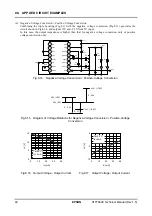
8. APPLIED CIRCUIT EXAMPLES
S1F76640 Technical Manual (Rev.1.5)
EPSON
17
8. APPLIED CIRCUIT EXAMPLES
(1) Quadruple boosting, Triple Boosting and Double Boosting
Fig.8.1 shows a connection example for obtaining quadruple boosting output for input voltage by operating
the booster only.
For triple boosting, remove the capacitor C1 and jumper between the CAP1+ (pin No.11) and V
DD
(No.9)
pins; triple boosting (15V) is obtained from V
OUT
.
For double boosting, further remove the capacitor C2 and jumper between the CAP2+ (pin No.13) and
V
DD
(No.9) pins; double boosting (10V) is obtained from V
OUT
.
C1
10
μ
F
+
−
C2
10
μ
F
1
2
3
4
5
6
7
8 OSC2
OSC1
V
SS
XP
OFF
TC2
TC1
V
REG
RV
9
10
11
12
13
14
15
16
VRI
V
O
CAP1
+
CAP1
−
CAP2
−
CAP2
+
CAP3
+
V
DD
C3
10
μ
F
C4
10
μ
F
V
OUT
(=V
DD
×
4)
R
OSC
1M
Ω
V
SS
V
DD
+
−
+
−
+
−
V
SS
(0V)
V
DD
(
+
5V)
V
OUT
(
+
20V)
4
$
V
DD
Fig.8.1 Quadruple Booster Fig.8.2 Diagram of Voltage Relations
for Quadruple Boosting
(2) Quadruple
bo Stabilizer
Fig.8.3 shows an applied-circuit example for stabilizing the boosting output obtained in Fig.8.1 the
stabilizer and providing the temperature gradient for the V
REG
output through the temperature gradient
selection circuit.
This application example can indicate two outputs from V
O
and V
REG
at the same time.
Triple bo stabilizer operation using the triple boosting and double bo stabilizer operation is
also available.
1
2
3
4
5
6
7
8
9
10
11
12
13
14
15
16
OSC2
OSC1
V
SS
XP
OFF
TC2
TC1
V
REG
RV VRI
V
OUT
CAP1
+
CAP1
−
CAP2
−
CAP2
+
CAP3
+
V
DD
-
C4
10
μ
F
V
OUT
(=V
DD
×
4)
R
OSC
1M
Ω
-
C1
10
μ
F
+
−
-
C2
10
μ
F
-
C3
10
μ
F
V
DD
R2
R1
+
-
-
C5
10
μ
F
V
REG
(=
V
SS
R
RV
1M
Ω
#
Note 1
R1
+
R2
R1
)
・
V
RV
+
−
+
−
+
−
V
SS
(0V)
V
DD
(
+
5V)
V
OUT
(
+
20V)
4
$
V
DD
V
REG
Fig.8.3 Quadruple Bo Stabilizer Fig.8.4 Diagram of Voltage Relations
(Temperature Gradient of C
T1
) for Quadruple Bo
Stabilizer
Note 1: The RV pin (No.1) has high input impedance. If the wire is long, use a shield wire or the like to prevent
noise. To reduce the influence of noise, it is effective to reduce the R
RV
value. (However, the R
RV
current consumption will increase.)











































